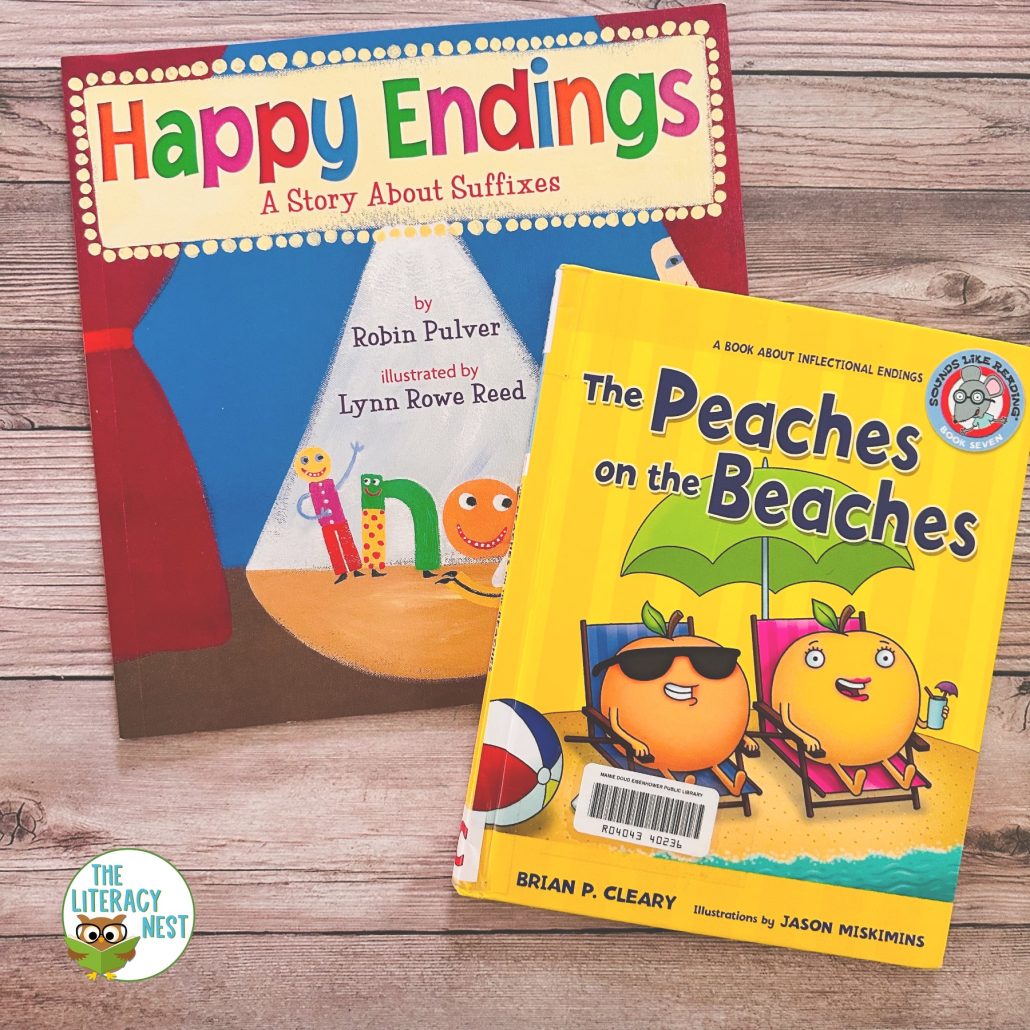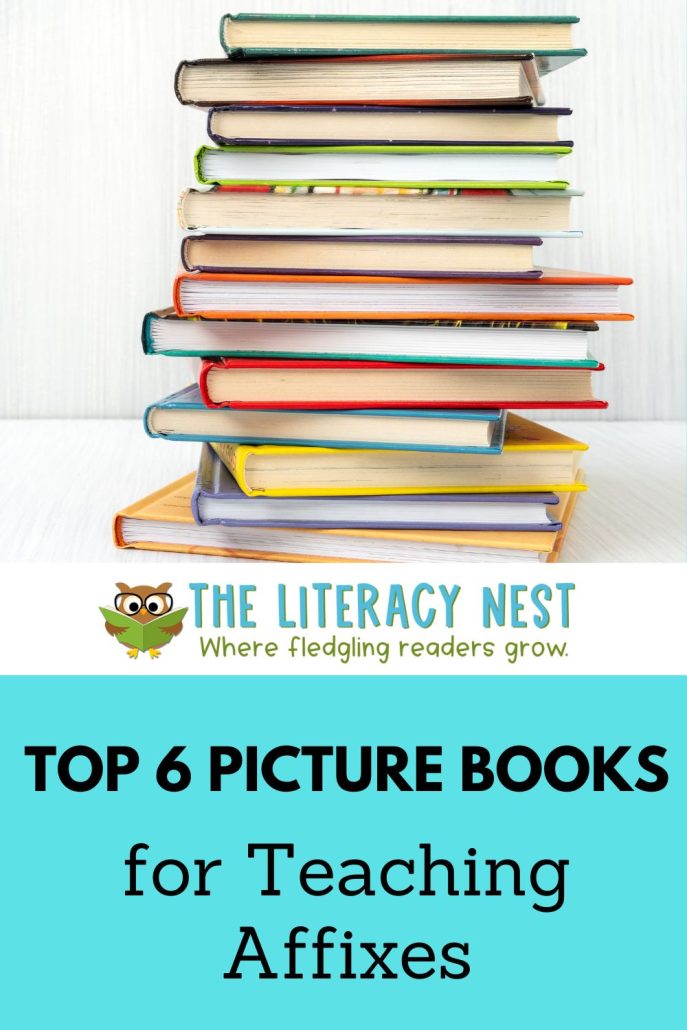Top 6 Picture Books for Teaching Affixes

One of the logical places to start to teach students about morphology is with prefixes and suffixes added to base words. Even quite young students can understand inflective endings such as -ing, -ed, and -s and basic prefixes such as un-, non-, and re-. This collection of picture books is perfect for helping with teaching affixes and the concepts of prefixes and suffixes and offer specific examples of each.
Here are My Six Favorite Books for Teaching Affixes!
Download and print this book list for teaching affixes, here!
1. If You Were A Suffix by Marcie Aboff
This picture book for elementary students introduces the concept of a suffix with a simple child-friendly definition. The repetitive line “If you were a suffix…” is reminiscent of the childhood favorite If You Give A Mouse A Cookie. It is an entertaining way to provide interesting information.
This book is an excellent age-appropriate introduction to morphology for young learners. It includes sweet examples and colorful, silly illustrations. This story is a great introduction to several high-use suffixes. The book also includes some hands-on activities for students to learn more about using suffixes. This author has several books related to grammar and words that are worth checking out. This series is called Word Fun.

2. If You Were Prefix by Marcie Aboff
This book is also part of the Word Fun series. It is aimed primarily at early elementary students and gives a child-friendly definition of what a prefix is, as well as giving the meanings and examples of several high-use prefixes. Like its partner book about suffixes, this book is modeled after the structure of If You Give A Mouse A Cookie. It gently informs and teaches complex concepts in a child-friendly way. The animal illustrations are cute and engaging.
3. The Peaches On The Beaches: A Book About Inflectional Endings by Brian P Cleary
This picture book serves double duty both as an exercise in phonological awareness and instruction on inflective endings. The format of the book is set up as a list of words on the left page and a funny sentence on the right. This is designed as an interactive book inviting children to identify additional rhyming words and locate the common inflective endings on each page.
The illustrations are cartoon-like and humorous. A mouse character pops in to invite student participation. The complexity of the sentences and the number of challenging words increases as the book goes on. This is part of a series by the author called Sounds Like Reading. This series is aimed at children who are having some difficulty with learning to read and utilizes phonological awareness and phonics skills.

4. Happy Endings: A Story About Suffixes by Robin Pulver
This story is fun on many levels. It can be enjoyed simply as a silly story or turned into an interactive lesson for teaching affixes. The suffixes themselves are characters in the story. When Mr. Wright tells the children on the last day of school that they will be tackling suffixes after lunch, the children are not excited. They are ready to start summer vacation. The suffixes take Mr. Wright’s words literally. They decide they do not want to be tackled, and they run away and hide. The story that follows shows the students how important word endings can be. The print highlights the word endings as they’re used in the story. The suffix characters provide examples of their usage through their speech bubbles. The text even hints at suffixing spelling rules and would make an excellent review for that purpose.
This author also wrote Punctuation Takes A Vacation and this is in a similar style. While it seems aimed at elementary students, it is my belief that this book can be used in different ways at different levels and is fun for all ages.
5. Pre- And Re-, Mis- And Dis-: What Is A Prefix? by Brian P Cleary
This book, like its suffix partner, is also aimed at upper elementary students. The rhyming story teaches students about the characteristics of prefixes and how they work as well as providing numerous examples and the meanings of different common prefixes. The text itself has words with prefixes in color with the prefix itself made bold. In at least several examples, additional words are found in the illustrations. While this book would make an excellent introduction to prefixes, it also has further utility as it includes a list of the included prefixes and their meanings at the back.

6. -Ful, and -Less, -Er and -Ness: What is a Suffix? by Brian P. Cleary
This picture book introduction to suffixes is for a slightly older crowd, such as mid to upper-elementary age. This book also presents a child-friendly definition of a suffix and introduces the meanings and demonstrates its use through a humorous rhyming story. The playful illustrations of funny cats are engaging, while not appearing too babyish. This author also has a series of books related to grammar utilizing the same characters. The series is entitled Words Are CATegorical.
Take a peek inside these picture books! Watch, Fun Picture Books to Teach Affixes!
Because English is a morpho-phonological language, it is important to include the study of morphology from early on. These books are an excellent introduction to this concept both for classroom instruction and for the intervention setting. Most of these books can be used both as a read-aloud and for interactive activities, allowing one book to serve as a jumping-off point and resource for an entire unit. Several of the books even include additional activity suggestions to do with your child or students.
Looking for more picture book suggestions? Check out these book lists!
- The Top 6 Picture Books For Building Phonological Awareness
- Children’s Books to Explain the Science of Reading
- 10 Children’s Books to Support Executive Function
- Children’s Books About The History of The English Language
Are you looking for an easy way to create a list of words with affixes? Word List Builder has got you covered!
Save time searching for words with affixes! Create customized and meaningful review, build your folder of words, create templates and games, and much more in Word List Builder.





